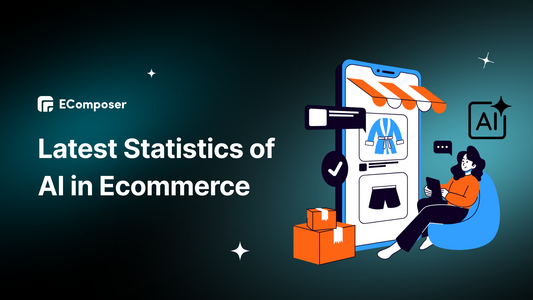The Future of AI in Ecommerce: Transforming Digital Retail & Beyond

Table Of Contents
AI is already having a significant impact on how we shop online, and this is only the beginning. AI is transforming online growth, sales, and purchasing. For example, it can create hyper-personalized customer journeys and stores that optimize themselves. Find out about the most important trends, how they will affect your return on investment, and what to expect in the years 2025–2030. Also, learn how to get your business ready for the next wave of smart, data-driven retail.
AI is at the heart of the changes that are happening in the world of online shopping. What was once a futuristic idea is now the foundation of modern digital retail. It has changed everything from how people shop to how stores keep track of their inventory in real time.
In this blog, we’ll explore how AI is reshaping ecommerce today, the technologies driving its future, and what businesses can do to stay ahead in an increasingly intelligent marketplace.
The Current State of AI in Ecommerce (2025)
Artificial intelligence in ecommerce has moved well past the “lab experiment” stage — in 2025, it’s an operational reality. Retailers and online merchants are using AI across the entire customer journey and the supply chain: to recommend products, run conversational agents, automate pricing, detect fraud, and even generate marketing copy.
Below, I define what AI means in this context, show where the market stands, summarize adoption across sectors, list the leading technologies, and explain why AI is shifting from novelty to business staple.
Market size & growth - the view from multiple reports
Estimates for the size of the AI market in retail and ecommerce differ depending on how you define it, but all analysts agree on one thing: it’s growing fast.
Most reports put today’s market value in the tens of billions of dollars, with forecasts reaching tens to even hundreds of billions by 2030. That means annual growth rates (CAGR, or Compound Annual Growth Rate) typically fall between 23% and 32%, depending on how broad the study’s scope is.
For instance, Grand View Research and Technavio project steady mid-20% growth, while MarketsandMarkets and Mordor Intelligence estimate higher figures when they include more retail-related AI use cases.
Why such wide ranges? Each study looks at slightly different slices of the market — some focus on AI specifically for ecommerce. In contrast, others include AI-powered retail systems or even next-generation agentic AI tools.
Leading AI technologies in ecommerce (what’s actually used)
- Recommendation engines/personalization (ML-based): The most visible and revenue-proven use case — product suggestions, emails, homepages that adapt in real time.
- Conversational AI & chatbots (NLP): Customer support, guided selling, and conversational commerce.
- Computer vision: Visual search, virtual try-ons, automated photo tagging, and quality inspection.
- Demand forecasting & dynamic pricing (ML + optimization): Helps match inventory to demand and price dynamically for margin or volume goals.
- Generative AI for content: Product descriptions, ad copy, A/B test variants, and creative assets are increasingly produced or accelerated by LLMs.
- Agentic AI & orchestration layers: Emerging tools that chain capabilities (search, transact, notify) into autonomous workflows — an advanced wave that’s shifting more decision-making to AI.
Transforming Customer Experience with AI
Hyper-Personalization at Scale
Personalization isn’t new, but AI has turned it from a marketing buzzword into precision science.
By analyzing massive data sets from browsing history, purchase behavior, time on site, and even micro-interactions like scroll speed or dwell time, machine learning models build a living profile of each shopper.

ASOS, a fashion store, uses AI to customize product suggestions and homepage layouts for each user, which boosts conversion rates and the average order value. Also, Shopify stores that use AI-powered recommendation apps say that personalized experiences can boost sales by up to 30%.
Why it matters:
Hyper-personalization enhances not only sales but also brand loyalty. Shoppers feel seen and understood, a key psychological trigger in digital buying behavior.
Conversational Commerce & AI Assistants
Forget clunky chatbots that spit out generic answers. The new era of Conversational AI brings fluid, human-like interaction into ecommerce.
Large Language Models & Natural Language Processing have made it possible for AI assistants to execute the following tasks:
-
Recommend products based on intent (“I need a lightweight running shoe for wet weather”)
-
Guide checkout processes or upsell complementary items
-
Offer 24/7 multilingual support
-
Handle post-purchase requests like returns or shipment tracking.
Platforms like Shopify Magic and Amazon's Rufus AI are at the forefront of this change, turning customer questions into chances to make a sale.
Pro Tip: When conversational AI is fully connected to your product database, CRM, and marketing tools, it works best. This makes sure that customers get answers that are aware of the situation and don't sound like robots.
Visual Search & Augmented Reality
Ever spotted a jacket on Instagram and thought, “I want that exact one”? With AI-driven visual search, now you can.
Computer Vision lets users upload or capture an image, and the AI identifies similar products instantly — matching color, texture, and even design patterns. This bridges the gap between inspiration and purchase.
AI-powered augmented reality (AR) lets people "try before they buy." IKEA and Gucci are two brands that make furniture and clothes that use AR to show customers how things will look in their homes, like sneakers on feet or couches in living rooms.

Results speak volumes:
-
AR experiences increase conversion rates by up to 40%.
-
Shoppers interacting with 3D or AR visuals show higher confidence and fewer returns.
Why it matters: AI-driven visuals close the sensory gap in online shopping — turning uncertainty into assurance and browsers into buyers.
AI-Powered Ecommerce Operations
From predicting what products to stock next month to catching fraud in milliseconds, AI has become the operational backbone of digital retail. Let’s dive into the three areas where it’s making the biggest impact.
Inventory Management & Supply Chain Optimization
Today’s AI systems can analyze thousands of real-time signals — weather patterns, regional search trends, influencer campaigns, and even local holidays — to predict what customers will want and when.
How it works:
-
Machine Learning models forecast demand with precision, helping retailers avoid both overstock and stockouts.
-
Computer vision systems track product flow in warehouses, automatically updating inventory counts via smart cameras.
-
Predictive logistics tools make shipping routes and fulfillment centers more efficient so that deliveries take less time and cost less.

Example: Global retailers like Walmart and Zara use AI-powered supply chain algorithms to automatically adjust inventory levels based on store performance and demand predictions. Shopify merchants now have access to similar predictive tools through apps that integrate with fulfillment networks.
Dynamic Pricing & Revenue Optimization
Pricing is one of ecommerce’s most sensitive levers — change it too slowly, and you lose competitiveness; too often, and you lose trust. Enter AI-driven dynamic pricing, a data-powered balancing act between demand, competition, and customer behavior.
What AI does:
-
Monitors market trends, competitor prices, and customer purchase intent in real time.
-
Uses reinforcement learning to test pricing strategies automatically.
-
Adjusts prices to maximize revenue, conversion rates, or profit margins depending on business goals.
Real-world app: Amazon famously updates prices millions of times per day using AI. Smaller ecommerce players can now do the same through accessible tools that plug directly into Shopify or BigCommerce, enabling smart price adjustments based on inventory, seasonality, and user engagement.
Fraud Detection & Risk Management
With ecommerce sales booming, so are online fraud attempts — but AI is proving to be the ultimate watchdog.
Old fraud systems used static rules, like "flag any purchase over $500 with mismatched ZIP codes." AI-based fraud detection is much more advanced today. It looks at hundreds of behavioral and transactional data points in real time.
Key capabilities include:
-
Anomaly detection: Identifying unusual spending or login patterns instantly.
-
User behavior analytics: Building profiles to differentiate real shoppers from bots or bad actors.
-
Adaptive learning: Models continuously evolve as new fraud tactics appear.
Example: Platforms like Stripe Radar, Shopify Protect, and Signifyd leverage AI to stop fraudulent transactions before they complete — saving merchants time, money, and chargeback headaches.
Marketing Transformation Through AI

AI-Driven Content Creation
Creating marketing content used to be a time-consuming art — now it’s a data-powered collaboration between humans and machines.
Generative AI models can make a lot of high-quality marketing materials, like product descriptions, ad copy, blog posts, and social media visuals, by training on a lot of text, image, and video data. But the magic lies in the synergy: marketers set the tone, and AI brings the ideas to life faster than ever.
Predictive Customer Analytics
Marketing success has always depended on understanding customers — and now AI makes that understanding deeper, faster, and predictive.
By combining machine learning with real-time data streams (website behavior, purchase patterns, email engagement, social interactions), AI can forecast:
-
Who’s most likely to buy again (and when).
-
What groups of customers are most likely to leave?
-
What products are trending upward or downward?
-
Which campaigns will perform best for each audience?
Omnichannel Orchestration
Customers today move seamlessly between devices, platforms, and channels — and they expect brands to follow. AI is now the conductor ensuring every touchpoint plays in perfect harmony.
Through AI-driven orchestration, marketers can:
-
Sync messaging across email, SMS, social, and on-site experiences.
-
Use real-time behavioral triggers (like abandoned carts or product views) to deliver personalized follow-ups instantly.
-
Optimize timing and frequency using engagement data — sending messages when each individual is most likely to respond.
The Business Impact: ROI of AI in Ecommerce
Artificial Intelligence isn’t just a buzzword anymore — it’s a bottom-line driver. For ecommerce businesses, AI has evolved from an “experimental add-on” to a strategic investment with measurable returns. The question is no longer “Should we use AI?” but rather “How fast can we scale it for maximum ROI?”
Operational Efficiency That Cuts Costs
AI automates what used to require hours of manual work — from order fulfillment to customer support.
-
AI chatbots handle up to 70% of routine inquiries, cutting support costs dramatically.
-
Automated inventory management stops problems with having too much or too little stock, which saves money on storage and lost sales.
-
Predictive logistics tools optimize shipping routes and delivery times, trimming operational expenses.
These savings add up quickly, and AI-powered online stores can save 20% to 30% on all of their costs.
Revenue Growth Through Personalization
AI-powered recommendation engines are quietly becoming ecommerce’s most powerful sales tool.
-
Personalized product suggestions can increase average order value (AOV) by up to 15–25%.
-
Retargeting algorithms analyze browsing and purchase behavior to convert abandoned carts into actual sales.
-
Dynamic homepage experiences adapt to each user in real-time — a subtle but powerful way to drive conversions.
Smarter Marketing Spend & Higher ROI
Instead of blasting every customer with the same campaign, AI analyzes purchase intent, engagement history, and predictive models to deliver hyper-targeted ads.
-
AI-driven ad optimization improves ROAS (Return on Ad Spend) by up to 50%.
-
Machine learning models identify the best-performing audiences and channels — reallocating your budget in real time.
Data-Driven Decision Making
AI tools transform data overload into actionable insight.
-
Businesses may remain ahead of the competition by using predictive analytics to make educated guesses about future events and consumer preferences.
-
Pricing algorithms adjust product prices dynamically based on demand, competition, and seasonality.
Long-Term Value Creation
Beyond short-term metrics, AI fuels customer lifetime value (CLV) and brand loyalty.
-
Personalized post-purchase experiences — like smart email recommendations and predictive reordering — keep customers coming back.
-
AI-powered feedback analysis helps brands improve faster by identifying recurring pain points.
Businesses that strategically integrate AI report an average ROI of 3x–8x within the first year, depending on scale and use case maturity.
The Future: Emerging AI Trends in Ecommerce (2025-2030)
If the last ten years were about putting commerce online, the next ten years will be about making it work on its own. From 2025 to 2030, ecommerce will go from being AI-assisted to AI-driven. This means that algorithms will not only help people make decisions, but they will also make them. What happened? Smarter stores, operations that are faster, and shopping experiences that feel almost real.
Autonomous Commerce & Self-Optimizing Systems
Picture an online store that can run itself, changing prices, adding new items to the inventory, redesigning product pages, and starting campaigns without anyone having to do anything.
That’s autonomous commerce: the next evolution of AI-driven retail.
These systems continuously learn from millions of data points, browsing behavior, conversion rates, even competitor trends, and self-optimize for performance. By 2030, leading ecommerce platforms are expected to feature fully autonomous optimization loops, where AI manages everything from logistics forecasting to website UX personalization — all in real time.
AI Agents Acting on Behalf of Consumers
Get ready for the rise of AI shopping agents, personal digital assistants that don’t just recommend products, but buy them for you.
Imagine saying: “Find me the best eco-friendly sneakers under $100, in my size, that ship within 2 days.”
Your AI agent scans multiple stores, compares prices, reads reviews, checks sustainability ratings, and completes the purchase — all in seconds.
By the late 2020s, these agents will negotiate discounts, track deliveries, and even return unwanted products automatically. This shift will fundamentally redefine customer acquisition: ecommerce brands will start optimizing for AI agents as the buyers, not just humans.
Synthetic Shopping Experiences & Metaverse Integration
The line between ecommerce and entertainment will blur even further. Synthetic shopping — powered by AI and 3D environments — will let customers walk through virtual stores, interact with AI sales associates, and “try on” products through AR-powered avatars.
Retailers will create AI-generated metaverse spaces where product displays change based on the interests and feelings of each visitor. Imagine walking into a digital Nike store that changes its layout right away based on your running goals, style, and fitness history.
Emotion AI & Sentiment Evolution
Next-generation Emotion AI will interpret facial expressions, tone of voice, and micro-interactions to gauge customer sentiment in real time.
This technology enables ultra-personalized engagement:
-
Websites that adjust visuals and messaging based on mood.
-
AI chatbots that sense frustration and change tone or escalate support instantly.
-
Product recommendations that align with emotional context (like showing “comfort items” during stressful times).
Ethical AI & Transparent Algorithms
As AI becomes more and more a part of online shopping, trust will depend on ethics and openness. Customers already want to know why certain products are suggested or how prices are set.
Brands that embrace explainable AI (XAI) — systems that clarify decision-making — will win long-term loyalty. Meanwhile, regulatory frameworks will push for responsible data use, algorithmic fairness, and bias-free personalization.
The Convergence of Physical & Digital Retail
Finally, the boundary between online and offline will dissolve completely. AI-powered phygital experiences blending physical stores with digital intelligence will dominate retail strategy.
Picture this:
-
Smart mirrors that recall your online browsing history.
-
In-store AI assistants that recommend items based on your digital cart.
-
Real-time inventory synchronization between online platforms and physical outlets.
By 2030, shopping won’t be defined by where it happens, but by how seamlessly the experience flows across every channel.
Action Plan: Implementing AI in Your Ecommerce Business
The idea of “AI transformation” can sound intimidating, like something only enterprise giants with data scientists and billion-dollar budgets can pull off. But here’s the truth: every ecommerce business, from small Shopify stores to multinational retailers, can leverage AI right now.
Assess Your AI Readiness: Where Do You Stand?
Before diving in, evaluate how ready your business is for AI adoption. Use this quick AI readiness framework across five dimensions:
|
Dimension |
Key Question |
What to Evaluate |
|
Data |
Do you collect and store quality data? |
Transaction, customer, and behavioral data cleanliness and structure |
|
Technology |
Is your current stack compatible with AI tools? |
APIs, integrations, cloud infrastructure |
|
People |
Does your team understand AI basics? |
Skills, willingness to adapt, openness to automation |
|
Processes |
Are workflows digitized or still manual? |
Repetitive, rule-based tasks ideal for automation |
|
Strategy |
Do you have defined goals for AI use? |
Business objectives aligned with measurable outcomes |
Pro Tip: Even simple analytics tools (like Shopify’s data dashboard or Google Analytics) can reveal whether your data foundation is AI-ready.
Prioritize AI Projects by Impact & Feasibility
AI works best when it solves a specific, high-impact problem — not when it’s added everywhere at once.
Use this simple Impact–Effort Matrix:
-
High Impact / Low Effort: Quick wins like product recommendations, automated customer service, or churn prediction.
-
High Impact / High Effort: Long-term projects such as AI pricing engines or custom machine learning models.
-
Low Impact / Low Effort: Supportive automations (e.g., email segmentation, content tagging).
-
Low Impact / High Effort: Avoid — low ROI, high resource drain.
Start with quick wins to build momentum, validate ROI, and earn buy-in before scaling complex systems.
Build vs. Buy: Which AI Path Fits You Best?
When using AI, ecommerce brands have to make a big choice: Should you make your own AI or buy tools that are already made?
|
Factor |
Build |
Buy |
|
Control |
Full customization and IP ownership |
Limited flexibility, but faster deployment |
|
Cost |
High upfront investment |
Subscription-based, low initial cost |
|
Speed |
Slower, requires expertise |
Rapid setup, minimal coding |
|
Maintenance |
Ongoing developer support |
Vendor handles updates |
|
Best For |
Enterprises with in-house tech teams |
SMBs seeking fast results |
Manage Change: Empower People, Not Just Machines
It's not just about algorithms that make AI work; it's also about people and processes using them. Common problems are employees who don't want to use AI because they think it will take their jobs or workflows that aren't clear.
To overcome this:
-
Educate: Run internal workshops explaining how AI enhances, not replaces, human roles.
-
Involve: Let team members help design new AI workflows.
-
Communicate: Share success metrics and celebrate time savings or improved results.
-
Iterate: Adjust systems based on real-world feedback.
Define Success Metrics & Measure ROI
You can't make things better if you don't keep track of them. Set clear metrics from the start that are linked to your business goals.
Examples of AI success metrics:
-
Revenue Growth: % increase in sales from AI recommendations
-
Operational Efficiency: Time saved on manual
-
Customer Experience: Improved satisfaction scores (CSAT, NPS)
-
Marketing ROI: Better ad performance, reduced acquisition cost
-
Error Reduction: Lower stockouts, fewer manual mistakes
Keep an eye on both short-term results (like an increase in conversions) and long-term changes (like lower costs or higher lifetime value).
Frequently Asked Questions
1. How much does it cost to use AI in an online store?
The price can be very different depending on how big and complicated your implementation is.
-
Small businesses can start with AI-powered apps and integrations for as little as $30–$300/month (e.g., chatbots, product recommendations, or marketing automation).
-
Mid-sized retailers investing in predictive analytics or customer segmentation tools typically spend $5,000–$50,000 annually.
-
Enterprises building custom AI models for pricing, inventory, or logistics can invest hundreds of thousands — but the ROI often outweighs costs within the first year.
2. How long does it take to see ROI from AI implementation?
For most ecommerce brands, initial ROI appears within 3–6 months for quick-win use cases like personalization or automated customer service.
More complex systems — such as predictive inventory management or AI pricing engines — can take 12–18 months to deliver full ROI, depending on data quality and operational maturity.
AI's power grows over time: as your models learn from new data, your return on investment (ROI) goes up by a lot.
3. Which AI technologies provide the quickest impact for ecommerce?
If you’re looking for immediate results, start with these:
-
AI Chatbots & Virtual Assistants: Reduce support costs and improve response times.
-
Personalized Product Recommendations: Boost conversion rates and average order value
-
AI-Driven Email & Ad Targeting: Increase marketing ROI through precision targeting.
-
Predictive Analytics: Forecast demand and reduce inventory waste.
These technologies are fast to deploy and deliver measurable performance gains within weeks.
4. How can small businesses compete with enterprise AI capabilities?
You don’t need a massive tech team to harness AI power. Today’s ecommerce ecosystem is filled with no-code AI tools that democratize access.
-
Use Shopify or WooCommerce integrations for AI-powered recommendations, pricing, or email automation.
-
Leverage marketing platforms (like Klaviyo or HubSpot) that include built-in machine learning.
-
Focus on niche personalization — small stores can win through deeper customer relationships rather than data volume.
In short, agility beats scale. Small brands that move fast can outsmart — not outspend — enterprise giants.
5. What skills are needed to manage AI-powered ecommerce?
You don’t need to be a data scientist to succeed with AI. However, having a team that understands data literacy and strategic automation is crucial.
Key skills include:
-
Analytical thinking: Understanding what data means for business decisions.
-
AI tool proficiency: Knowing how to configure and interpret AI apps or dashboards.
-
Creative problem-solving: Identifying where automation adds the most value.
-
Change management: Leading teams through digital transformation.
As AI evolves, strategic understanding will matter more than coding expertise.
6. How does AI impact customer privacy in ecommerce?
This is one of the biggest questions — and concerns — in AI adoption.
AI thrives on data, but ethical businesses use it transparently and responsibly. That means:
-
Collecting only necessary customer data.
-
Disclosing how AI systems make recommendations.
-
Complying with regulations like GDPR and CCPA.
-
Offering clear opt-in/opt-out options for data collection.
The future of ecommerce AI lies in “trust-based personalization” — where customers willingly share data because they see genuine value in return.
7. Is AI in ecommerce accessible to non-technical business owners?
Absolutely. Modern AI tools are designed to be no-code or low-code, making them accessible even for non-technical users.
Most ecommerce platforms (like Shopify, BigCommerce, or Wix) already integrate AI features natively — from predictive search to automated email marketing. You don’t need to write a single line of code; you just need to choose the right app or plugin.
As AI continues to evolve, usability is becoming its strongest feature — empowering creativity, not replacing it.
You may also like
-
How to use AI to Build A Shopify Store
-
Top 10 Best Free AI Human Generators
-
What is AI in Ecommerce? Definition, Benefits & Comprehensive Apps
-
How AI Personalization Is Transforming eCommerce
-
9 Best AI for Shopping To Save Time And Money
Final Thoughts
Artificial Intelligence has gone from being a behind-the-scenes tool to the main force behind new ideas in digital retail, changing how brands work, connect with customers, and grow. Stores that used to react now predict, and businesses that used to rely on gut feelings now rely on insight. The best ecommerce experiences of tomorrow will blend the analytical power of AI with the empathy, storytelling, and vision only humans can provide.






















0 comments